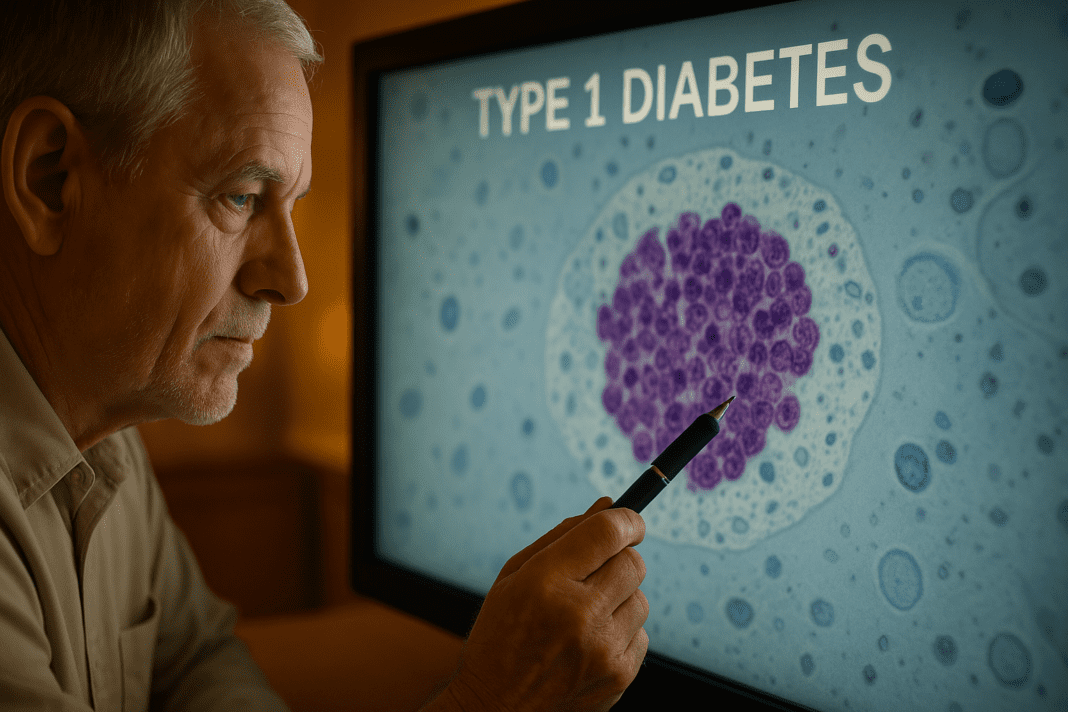Type 1 diabetes (T1D) is a complex autoimmune disorder that primarily affects the body’s ability to produce insulin, a hormone necessary for regulating blood glucose levels. While the disease has been known for centuries, the understanding of its pathophysiology continues to evolve, especially in light of recent medical research. In this article, we will explore the pathophysiology of type 1 diabetes, examining the mechanisms that drive the disease, recent advances in understanding its onset and progression, and how this knowledge is influencing treatments and potential future cures.
You may also like: Breakthroughs in Current Diabetes Research: What the Latest Studies Reveal About Treatment and Prevention
What is Type 1 Diabetes? A Brief Overview
Type 1 diabetes is one of the two main forms of diabetes mellitus, alongside type 2 diabetes, but it is distinctly different in terms of its cause and progression. In individuals with type 1 diabetes, the immune system erroneously targets and destroys insulin-producing beta cells within the pancreas. This results in insufficient insulin production, which leads to high blood sugar (hyperglycemia). The pathology of type 1 diabetes is primarily characterized by this autoimmune attack, although there are other contributing factors such as genetic predisposition and environmental triggers.
Unlike type 2 diabetes, which is largely associated with insulin resistance and lifestyle factors, type 1 diabetes typically presents in childhood or adolescence, though it can develop at any age. The pathophysiology of T1DM (type 1 diabetes mellitus) is complex, involving a combination of genetic factors and immune system dysfunction. Understanding the pathophysiology of T1DM is crucial in developing more effective treatments and potential cures for the disease.

The Immune System’s Role in Type 1 Diabetes Pathophysiology
At the heart of the pathophysiology of type 1 diabetes lies the immune system’s misguided attack on the body’s own tissues. Specifically, the immune system targets and destroys the insulin-producing beta cells in the pancreas, which are located in clusters of cells known as the islets of Langerhans. This autoimmune response is thought to be triggered by a combination of genetic susceptibility and environmental factors such as viral infections.
Recent research into the pathophysiology of T1DM has focused on identifying the precise mechanisms by which the immune system recognizes and destroys beta cells. A key discovery in recent years is the role of specific immune cells, such as T cells, which are involved in this autoimmune destruction. These T cells mistakenly identify the beta cells as foreign invaders, leading to their destruction. This process is mediated by a variety of immune signals and is influenced by genetic variations that predispose individuals to autoimmune diseases.
Studies have also shown that certain viral infections, such as enteroviruses, may act as environmental triggers for the onset of type 1 diabetes. These viruses can potentially cause molecular mimicry, where the immune system attacks both the virus and the body’s own cells, including beta cells. Understanding the immunological mechanisms behind the destruction of beta cells is crucial for developing therapies that can prevent or halt this autoimmune process.
Genetic Factors and Their Influence on Type 1 Diabetes Pathophysiology
While autoimmune destruction of beta cells is central to the pathophysiology of type 1 diabetes, genetic factors also play a significant role in an individual’s susceptibility to the disease. Researchers have identified a number of genes associated with an increased risk of developing T1DM, particularly those involved in immune system regulation. The most well-known of these genes are located in the human leukocyte antigen (HLA) region, which plays a critical role in immune response.
The HLA system helps the immune system distinguish between the body’s own cells and foreign invaders, such as bacteria and viruses. Certain variations in the HLA genes are associated with a higher risk of developing type 1 diabetes. These genetic factors contribute to the dysregulation of the immune system, making it more likely to attack the body’s own cells, including insulin-producing beta cells.
However, genetic susceptibility alone does not guarantee that an individual will develop type 1 diabetes. It is thought that environmental factors, such as viral infections, may act as triggers in genetically predisposed individuals. This complex interaction between genetic predisposition and environmental factors is a key area of research in understanding the pathophysiology of type 1 diabetes.
Beta Cell Dysfunction and Insulin Deficiency
The hallmark of type 1 diabetes is the loss of functional beta cells in the pancreas, which leads to insulin deficiency. Insulin is a hormone that helps regulate blood glucose levels by facilitating the uptake of glucose into cells for energy. Without sufficient insulin, blood sugar levels rise, leading to hyperglycemia. Over time, the lack of insulin can result in serious complications, including cardiovascular disease, kidney failure, and nerve damage.
The process of beta cell destruction begins early in the development of type 1 diabetes, but it can take years before symptoms manifest. In the early stages, the immune system attacks beta cells in the pancreas, causing inflammation. This stage is known as insulitis, and while beta cell destruction is occurring, some beta cells may continue to function, producing small amounts of insulin. As the disease progresses, however, the destruction becomes more widespread, and insulin production becomes severely impaired.
Recent advancements in understanding the pathophysiology of type 1 diabetes have highlighted the potential for beta cell regeneration or transplantation as a therapeutic option. Research into stem cell therapies, for example, is exploring the possibility of creating new beta cells from other cell types to replace those that have been lost. Additionally, efforts are being made to develop immunotherapies that could prevent or slow the immune system’s attack on beta cells.

The Role of Autoantibodies in Type 1 Diabetes Pathophysiology
Autoantibodies are antibodies that mistakenly target and attack the body’s own tissues, and they play a critical role in the pathophysiology of type 1 diabetes. These autoantibodies target specific components of the beta cells, including insulin, the enzyme glutamic acid decarboxylase (GAD), and the insulin receptor. The presence of these autoantibodies in the blood is one of the key diagnostic indicators of type 1 diabetes and is often used to predict the development of the disease in at-risk individuals.
In recent years, there has been increasing interest in the role of autoantibodies in both the diagnosis and prevention of type 1 diabetes. Studies have shown that the presence of multiple autoantibodies is associated with a higher risk of developing the disease, and monitoring these antibodies may help identify individuals who are at the greatest risk. This has opened up new possibilities for early intervention and prevention strategies.
Interestingly, while autoantibodies are a hallmark of type 1 diabetes, they do not directly cause beta cell destruction. Rather, they serve as markers for the autoimmune process and may contribute to the inflammatory environment that facilitates beta cell destruction. Understanding the role of autoantibodies in the pathophysiology of type 1 diabetes is crucial for developing new diagnostic tools and therapeutic strategies.
Advancements in Treatment and Future Directions
The pathophysiology of type 1 diabetes is complex and multifactorial, but recent research has led to significant advancements in both treatment and prevention strategies. Insulin therapy remains the cornerstone of treatment for individuals with type 1 diabetes, but recent advances have led to the development of more sophisticated insulin delivery methods, such as insulin pumps and continuous glucose monitors (CGMs). These technologies have improved blood sugar control and quality of life for individuals with T1D.
One of the most promising areas of research in the pathophysiology of type 1 diabetes is immunotherapy. As scientists gain a deeper understanding of the autoimmune processes that drive beta cell destruction, they are exploring ways to modulate the immune response. This could potentially slow or stop the progression of the disease, preserving beta cell function and preventing or delaying the need for insulin therapy.
Another exciting area of research is beta cell regeneration. Efforts are underway to identify ways to stimulate the body’s own ability to regenerate insulin-producing beta cells, either through stem cell therapies or by reprogramming other types of cells in the pancreas. While these approaches are still in the early stages of development, they offer hope for a future where individuals with type 1 diabetes may no longer need lifelong insulin therapy.

Frequently Asked Questions (FAQ) on the Pathophysiology of Type 1 Diabetes
1. What is the pathophysiology of type 1 diabetes, and how does it differ from type 2 diabetes?
The pathophysiology of type 1 diabetes (T1D) is primarily characterized by an autoimmune attack on the insulin-producing beta cells in the pancreas. This results in insufficient insulin production, leading to high blood glucose levels. Unlike type 2 diabetes, where insulin resistance is the main factor, the primary issue in type 1 diabetes is the destruction of beta cells. As a result, individuals with T1D require lifelong insulin therapy. Recent studies on the pathophysiology of T1DM have revealed a complex interplay of genetic susceptibility and environmental triggers, with viral infections and autoimmune processes playing significant roles in disease onset. Understanding this pathophysiology is key to developing more effective treatments and therapies for individuals with diabetes mellitus tipo 1.
2. How do immune system dysfunctions contribute to the pathology of type 1 diabetes?
In type 1 diabetes, the immune system mistakenly attacks the insulin-producing beta cells in the pancreas, which leads to their destruction and the eventual loss of insulin production. This autoimmune response is central to the pathology of type 1 diabetes. Immune cells, particularly T cells, recognize the beta cells as foreign and initiate an inflammatory process called insulitis, which further damages the pancreas. Recent research has focused on understanding the molecular mechanisms behind this immune attack, particularly in identifying the triggers that lead the immune system to target its own cells. Advances in immunology suggest that identifying these triggers could lead to preventative strategies to halt or slow the autoimmune process, a promising avenue in type 1 diabetes pathophysiology.
3. What role do genetic factors play in the development of type 1 diabetes?
Genetic factors play a significant role in determining susceptibility to type 1 diabetes. The most notable genes are found in the human leukocyte antigen (HLA) region, which is responsible for immune system function. Specific variations in these genes can increase the likelihood of developing the disease by causing an imbalance in immune regulation. However, genetics alone do not fully explain the onset of diabetes mellitus tipo 1. Environmental factors, such as viral infections, are believed to play a pivotal role in triggering the autoimmune response in genetically predisposed individuals. Researchers are currently investigating how genetic predisposition interacts with environmental factors to contribute to the pathophysiology of T1DM.
4. Can beta cell regeneration reverse the damage caused by type 1 diabetes?
Beta cell regeneration is an exciting area of research in type 1 diabetes treatment. Currently, beta cells are destroyed irreversibly in individuals with T1D, leading to insulin dependence. However, recent studies into stem cell therapy and regenerative medicine suggest the possibility of stimulating the regeneration of beta cells or replacing them through transplantation. While beta cell regeneration is still in the experimental stages, scientists are working on techniques to either reprogram other cells in the pancreas to become insulin-producing or develop artificial beta cells. Understanding the pathophysiology of type 1 diabetes better could lead to breakthroughs that slow down or prevent the loss of beta cells, offering hope for a future cure.
5. How do environmental factors influence the onset of type 1 diabetes?
Environmental factors, particularly viral infections, are believed to contribute significantly to the onset of type 1 diabetes. Certain viruses, like enteroviruses, may trigger an immune response that mistakenly targets the body’s own beta cells in a process known as molecular mimicry. This immune response, in turn, exacerbates the autoimmune attack on the pancreas. While genetic predisposition makes some individuals more susceptible, the influence of environmental factors underscores the complexity of the pathophysiology of type 1 diabetes. Ongoing research is examining how viral infections and other environmental factors can be managed to reduce the risk of developing T1DM.
6. What are autoantibodies, and how do they affect type 1 diabetes development?
Autoantibodies are antibodies produced by the immune system that mistakenly target the body’s own cells, and they play a critical role in the pathophysiology of type 1 diabetes. In T1D, autoantibodies target specific proteins found in the beta cells, including insulin and glutamic acid decarboxylase (GAD). The presence of these autoantibodies in the blood is often used as a diagnostic marker for type 1 diabetes. Their role, however, is more complicated than merely serving as markers—they contribute to the inflammation and autoimmune response that leads to beta cell destruction. Understanding autoantibodies’ role in T1DM could lead to early interventions and the development of therapies that modulate the immune response before beta cell destruction becomes severe.
7. What is insulitis, and why is it important in understanding type 1 diabetes?
Insulitis is an inflammatory process that occurs when immune cells, including T cells, infiltrate the pancreatic islets, where beta cells are located. It is one of the earliest signs of autoimmune activity in type 1 diabetes and is a key feature in the pathophysiology of T1DM. During insulitis, immune cells attack and destroy beta cells, leading to the gradual loss of insulin production. Understanding insulitis is critical for identifying the initial stages of type 1 diabetes, and recent research is focused on how to prevent or halt this process before it causes significant damage. Advances in immunotherapy and autoimmune disease treatments may offer strategies to intervene at the insulitis stage.
8. How does the pathology of type 1 diabetes affect long-term health outcomes?
The pathology of type 1 diabetes has long-term implications for health. Once beta cells are destroyed and insulin production is lost, individuals with T1DM must rely on insulin therapy to regulate blood sugar levels. However, chronic high blood sugar (hyperglycemia) can lead to a range of complications, including cardiovascular disease, nerve damage, kidney failure, and blindness. These complications are often linked to the underlying pathology of type 1 diabetes and the resulting damage to blood vessels and organs over time. Understanding how the disease progresses at the cellular level is crucial for developing treatments that prevent these complications, as managing glucose levels alone may not be sufficient to prevent long-term damage.
9. What new treatments are being developed to address the pathophysiology of type 1 diabetes?
Recent advances in the treatment of type 1 diabetes focus on addressing the root cause of the disease: the autoimmune destruction of beta cells. One promising avenue is immunotherapy, which aims to modulate the immune system to prevent it from attacking beta cells. Researchers are exploring various strategies, including the use of immune-suppressive drugs, vaccines, and other biologics to halt or slow the autoimmune response. Additionally, advancements in insulin delivery methods, such as artificial pancreas systems and continuous glucose monitoring (CGM), are improving blood glucose control. Understanding the pathophysiology of type 1 diabetes helps guide these innovations, offering hope for more effective and less invasive treatments.
10. Can type 1 diabetes be prevented, given what we know about its pathophysiology?
Prevention of type 1 diabetes remains a major challenge due to its complex genetic and environmental origins. However, with ongoing research into the pathophysiology of type 1 diabetes, particularly the role of immune system dysfunction and environmental triggers like viral infections, new strategies are emerging. Researchers are investigating vaccines and other preventative measures that could intervene early in the autoimmune process, preventing the destruction of beta cells before it occurs. Although a definitive cure or prevention strategy has not yet been discovered, understanding the factors that contribute to type 1 diabetes pathophysiology opens the door to potential future prevention programs, particularly for individuals at high genetic risk.
Conclusion: Moving Toward a Cure for Type 1 Diabetes
The pathophysiology of type 1 diabetes is a complex and evolving field of study, but recent advances in medical research are providing new insights into the mechanisms that drive this debilitating disease. From understanding the autoimmune processes involved in beta cell destruction to exploring innovative treatments like immunotherapy and beta cell regeneration, the future of type 1 diabetes care is promising.
As research continues to shed light on the underlying causes of type 1 diabetes, the hope is that more effective therapies and ultimately a cure will emerge. For individuals living with the disease, these advancements offer hope for better management and, eventually, a life free from the burden of insulin dependence. The progress being made in unraveling the pathophysiology of type 1 diabetes brings us one step closer to transforming the lives of those affected by this autoimmune disorder.
autoimmune diseases, insulin production, immune system dysfunction, beta cell destruction, glucose metabolism, chronic hyperglycemia, diabetes treatment research, insulin therapy alternatives, immune modulation in diabetes, autoimmune response in diabetes, type 1 diabetes complications, diabetes management, diabetes mellitus management, blood glucose regulation, insulin resistance, T1D research, pediatric diabetes, genetic predisposition to diabetes, viral triggers of diabetes, pancreatic function, beta cell regeneration
Further Reading:
Unraveling the Pathogenesis of Type 1 Diabetes with Proteomics: Present And Future Directions
Gene-environment interaction in the pathophysiology of type 1 diabetes
Diabetic Nephropathy: Challenges in Pathogenesis, Diagnosis, and Treatment
Disclaimer
The information contained in this article is provided for general informational purposes only and is not intended to serve as medical, legal, or professional advice. While MedNewsPedia strives to present accurate, up-to-date, and reliable content, no warranty or guarantee, expressed or implied, is made regarding the completeness, accuracy, or adequacy of the information provided. Readers are strongly advised to seek the guidance of a qualified healthcare provider or other relevant professionals before acting on any information contained in this article. MedNewsPedia, its authors, editors, and contributors expressly disclaim any liability for any damages, losses, or consequences arising directly or indirectly from the use, interpretation, or reliance on any information presented herein. The views and opinions expressed in this article are those of the author(s) and do not necessarily reflect the official policies or positions of MedNewsPedia.


